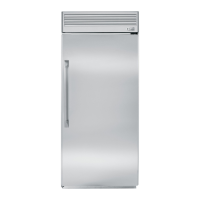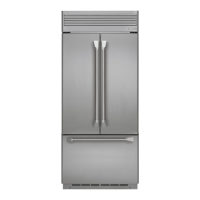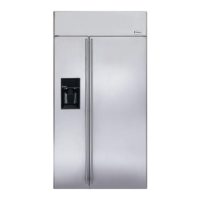
Do you have a question about the GE Monogram Refrigerator and is the answer not in the manual?
| Configuration | French Door |
|---|---|
| Ice Maker | Yes |
| Water Dispenser | Yes |
| Refrigerator Type | French Door |
| Energy Star Certified | Yes |
| Color | Stainless Steel |
Read the manual carefully for operation and maintenance. Keep handy for questions.
Record model and serial numbers from label for correspondence and service calls.
Contact the dealer or builder immediately if the refrigerator is received damaged.
Check Problem Solver first; then contact service personnel for assistance.
Covers intended use, installation, child safety, cold surfaces, flammable liquids, and pinch points.
Unplug before cleaning/repairs; recommend qualified technician for servicing.
Turn off Master Light switch before replacing bulbs to avoid contact with live filament.
Do not refreeze frozen foods that have completely thawed.
Follow disposal instructions to prevent accidents with old appliances.
Federal law requires refrigerants to be removed before product disposal.
Appliance must be properly grounded using a 3-prong plug and outlet for safety.
Do not use adapter plugs or extension cords; ensure proper grounding.
Do not pull cord to unplug; repair/replace damaged cords immediately.
Use +/- pads to change settings; allow 24 hours for stabilization.
Shows actual temps; lists low/high ranges for Fresh Food and Freezer compartments.
Press 'Temp Display °C/°F' pad to switch between Fahrenheit and Celsius.
Activates alarm if a door is left open for more than 2 minutes.
Replace when status light is red or ice quality degrades; filters 500 gallons.
Steps for installation, including filling cartridge and resetting status light.
Use bypass plug for RO systems or when replacement filter is unavailable.
Interactive panel, dispenser light, door alarm, and dispenser lock functions.
Select type, press glass against cradle; flush new water line for impurities.
Instructions for lifting out and reinstalling the ice storage bin.
Avoid overfilling, use correct glass size, do not quick-chill in bin, tilt glass for drips.
Crushed ice variations, water drips, snow formation, water temperature, and drip elimination.
Takes 12-24 hours for initial ice production; discard first bucket.
Switch operation and importance of the feeler arm for ice production control.
Old ice quality degrades; use ice frequently. Icemaker has a delay after being turned on.
SELECT TEMP, EXPRESS CHILL, and EXPRESS THAW for chilling, thawing, and storing foods.
Steps for operation, stopping features, countdown display, and post-thaw storage.
Note on temperature variations and food safety recommendations for thawing.
Lists specific foods for Citrus, Produce, and Meat settings (43°F, 34°F, 32°F).
Guide for chilling items in minutes and thawing items by weight and time.
How to lock and unlock the Climate Control drawer settings for safety.
Sealed deli pan for meats/cheese; sealed produce pans with adjustable humidity.
VEG (HI) for high humidity, FRUIT (LO) for lower humidity storage.
Lists foods for high and low humidity storage environments.
Step-by-step guide for removing drawers and pans from their holders.
Instructions for correctly reinstalling drawers and pans into their holders.
Adjustable shelves in fresh food and freezer compartments for efficient storage.
Steps to tilt, lift, and slide shelves out and back in.
Adjustable door bins; removable gallon bin for cleaning.
Rack attaches to shelf side for horizontal bottle storage, including 2-liter bottles.
Wire slide-out baskets for easy access to frozen foods.
Slide-out rack designed for easy access to frozen juices or foods.
Instructions for cleaning spill shelf, dispenser, and exterior panels.
Recommended cleaners and methods for maintaining stainless steel finish.
Steps for cleaning inside, including odor neutralization with baking soda solution.
Prohibits washing plastic parts or aluminum tray in the dishwasher.
Avoid hot water on cold glass shelves to prevent breakage.
Caution regarding intense heat; ensure power is off and lamps are cool before replacement.
Location and function of the master light switch for turning off compartment lights.
Details on Type 1 (MR11) and Type 2 (T) halogen bulbs used in the refrigerator.
Step-by-step guide for replacing Type 1 bulbs in fresh food and freezer compartments.
Warning: The light shield must be replaced to prevent heat damage.
Steps to replace Type 2 bulbs in the fresh food compartment light shield.
Removing and reinstalling the light housing and lamp assemblies.
Steps to replace bulbs in the Climate Control drawer lamp assembly.
Procedure and safety precautions for cleaning condenser fins annually.
Instructions for both long and short vacations, including power and icemaker settings.
Tips for securing items and maintaining upright position during transport.
Troubleshooting steps for when the refrigerator is not functioning.
Explains normal motor cycling and reasons for frequent on/off operation.
Guidance on allowing 24 hours for temperature to stabilize after initial setup or changes.
Identifies common sounds like fan noise, gurgling, and cracking as normal.
Addresses issues with doors not closing properly and potential causes.
Troubleshooting for compartments being too warm or having frost/ice crystals.
Addresses slow freezing, bad taste/odor, and causes like filter clogs or unsealed packages.
Troubleshooting steps for when the automatic icemaker does not work.
Explains moisture collection and refrigerator odors, with solutions.
Troubleshooting steps for a non-functional interior light.
Addresses small/hollow cubes, water on floor, dispenser not working, and poor water taste.
Troubleshooting door alignment and gaps between doors and cabinets.
Troubleshooting for water dispenser not working, spurting, or no production.
Explains when cubed ice is selected but crushed ice is dispensed.
Troubleshooting for food not thawing/chilling or controls not working.
Details operating specs, capacity, pressure, temperature, and flow rate for the water filter.
Guidance on water quality, installation, and maintenance for the filtration system.
Details of water treatment device certification for contaminant reduction.
Information on toll-free assistance, in-home repair, and contact numbers.
Assistance for special needs and details on purchasing extended service contracts.
How to order parts and accessories, including payment methods.
Details on the duration and scope of coverage for parts and labor.
Lists exclusions such as damage from misuse, accidents, or improper installation.











